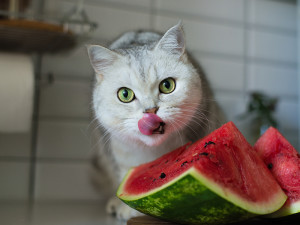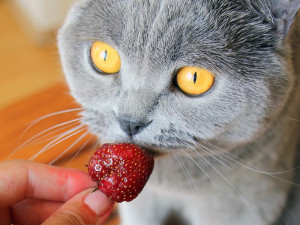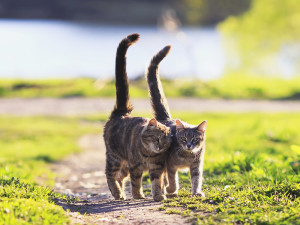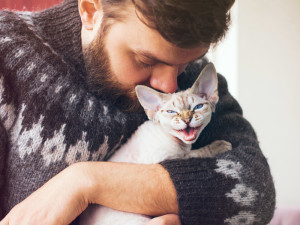What Fruits Can Your Cat Feast On?
Pass the fruit bowl – it’s treat time
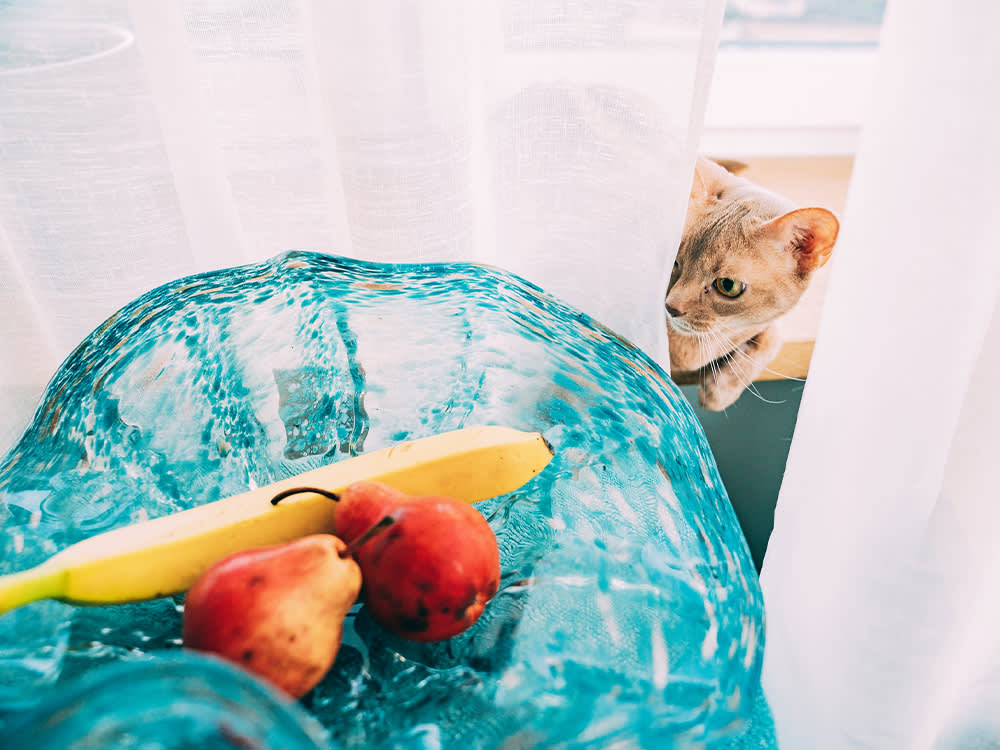
Share Article
We may bury citrus peels in the soil of our house plants to deter our cats from chompingopens in a new tab on them, but other forms of fruit may actually appeal to cats. Cats are obligate carnivores, meaning they don’t need to eat fruit, and their diets should consist primarily of protein, but some may enjoy fruit as an occasional treat. Cats lack the sweet receptors needed to detect the sweetness of sugar, but may enjoy the textures and smells of certain fruit, such as melon and strawberries.
Never feed cherries, grapes or raisins to a cat; these fruits are toxic to felines and can cause kidney damage and possibly death. We spoke with veterinarian and medical writer Dr Amy Fox – because when it comes to the safety of feeding your cat fruit, there’s no cherry-picking. So, go ahead and create a tiny fruit salad for your cat – just be sure to adhere to this list of the sweet stuff when offering them a taste.

littleKin™ is Kinship’s home just for puppy and kitten parents. Bop over to check out expert advice, new pet tools, and special deals—all curated for your newest family member.
opens in a new tab1. Apples
Cats can eat apples, but only in moderation. Peeled and boiled apples are easier for cats to digest, but cooked apples may contain additional ingredients that could be harmful to cats, such as sugar. Dried apples should be avoided because their water content is extracted, making their sugar concentration even higher.
While apples aren’t toxic to cats, their stems, leaves and seeds can be because they contain cyanide, which is poisonous to cats, so it’s important to avoid those when offering your cat a slice. “I recommend cutting up the fruit into small pieces and not giving them things with pits or seeds inside that could be choking hazards or cause an intestinal obstruction if swallowed,” says Dr Fox. “Round fruits, like berries, should be sliced into quarters for the same reasons.”
2. Blueberries
Blueberries have tons of antioxidants, vitamin C, vitamin K and fibre, making them a nutritious snack for berry-loving cats. Blueberries should not be a replacement for a complete and balanced diet and should never make up more than 10 percent of your cat’s daily calories. “Fruit can be given in small quantities as an occasional treat, but be sure the bulk of their diet is coming from a cat food labelled as complete and balanced,” says Dr Fox. Beware that feeding large blueberries to cats can be a choking hazard and all treats should be shared in bite-sized pieces.
3. Strawberries
Cats and berries mix pretty well. In fact, strawberriesopens in a new tab are considered an ideal treat for cats: they have tons of fibre, which can help treat constipation. They contain no protein or taurine, so they should only be used as an occasional snack, rather than a part of your cat’s regularly scheduled mealtime. According to Dr Fox, “If a cat were eating a lot of fruit, it might fill up on that and then they wouldn’t get enough of the nutrients they need from regular cat food.” Your cat may not even take to the fruity snack, since cats lack the flavour receptors to detect the taste of sugar.
4. Watermelon
Watermelonopens in a new tab’s high water content makes it a perfect snack for dehydrated catsopens in a new tab, which, let’s be real, is pretty much all cats. It’s low in calories and high in vitamin A, potassium, and lycopene, so you won’t have to worry about your cat packing on the pounds if they have a nibble or two. It’s important to remove the rind and seeds from watermelon before sharing it with your cat because they’re toxic and may lead to illness.
5. Melon
Melons are one of the better snacks for your cat; they’re high in vitamins A and C. Whether it’s melon, seedless watermelon or honeydew, giving your cat a nibble of the soft fruit can be an excellent treat – as long as the hard rind is removed, and it’s cut up into smaller pieces.
6. Pumpkin
Pumpkin is a safe treats that can be used to treat symptoms of an upset stomach, such as frequent hairballs, diarrhoea and constipation. Cooked or canned pumpkin is the way to go, as the kind of pumpkin you find in pumpkin-pie mix contains added spices, such as cinnamon, that can be toxic to cats.
7. Bananas
Although bananas are probably not the fruit your cat will be climbing up the walls for (if you haven’t seen the internet videos of cats gagging at bananasopens in a new tab, you need to), some cats may acquire a taste for the breakfast staple. When introducing any new human foods to your cat, it’s important to share only small quantities at a time and carefully monitor your cat’s reaction.
8. Cranberries
Some cat food is practically Christmas in a bowl. Fortunately, lots of cat foods already feature cranberry as an ingredient, so that tells us it’s relatively safe, but only in the right quantity. Cranberries can help treat UTIs and are a great source for the vitamins and essential minerals your cat needs.

Avery Felman
Avery is a writer and producer. She has written for numerous publications, including Refinery29, BuzzFeed, and V Magazine. When she’s not at her computer, you can find her reading, practicing her Greek on Duolingo, and delving into the Sex and the City discourse. She lives in Brooklyn, New York with her husband and their cat, Chicken, who rules with an iron fist.
Related articles
![Two cats walking with their tails sticking straight up]() opens in a new tab
opens in a new tabTail Talk: What Is Your Cat Trying to Tell You?
Cats are enigmas. But their tail movements can reveal a lot about their moods
![cat meowing]() opens in a new tab
opens in a new tabThe Cat’s Meow – What Does it All Mean?
How to decode your cat’s love language when one meow has many meanings
![Grey cat eats a strawberry]() opens in a new tab
opens in a new tabCan Cats Eat Strawberries?
Soon, they’ll be demanding you make this strawberry ice cream recipe on repeat
